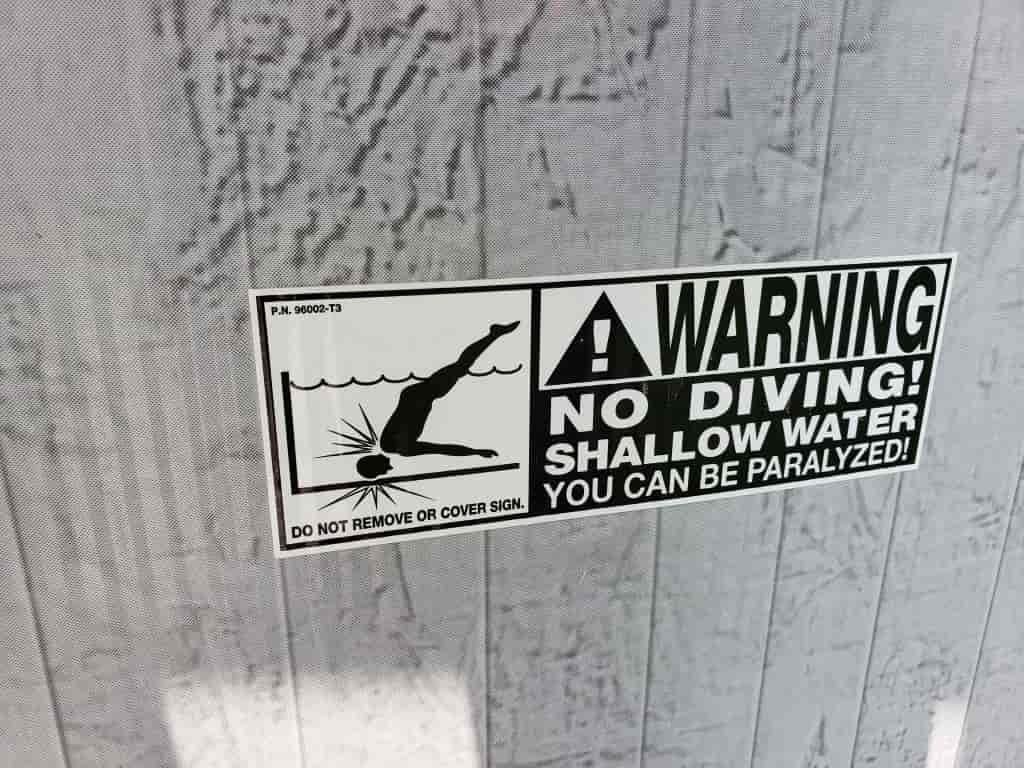As winter approaches, one of the important considerations for pool owners is how much water to drain from their above ground pool. Properly preparing your pool for the colder months can help prevent damage and ensure a smooth reopening come spring. But determining the ideal water level can sometimes be confusing. In this article, we will provide you with some helpful tips and guidelines on how much water to drain from an above ground pool for winter, so you can bid farewell to your pool with peace of mind.
Factors to Consider
Pool Size
When determining how much water to drain from your above ground pool for the winter, one important factor to consider is the size of your pool. The larger the pool, the more water you will need to drain. This is because leaving too much water in the pool can lead to costly and time-consuming repairs caused by ice expansion during freezing temperatures. On the other hand, draining too much water can potentially cause damage to the pool structure. Therefore, it is essential to find the right balance based on the size of your pool.
Climate
The climate in your area is another crucial factor to take into consideration when deciding how much water to drain from your above ground pool. If you live in an area with mild winters, you may not need to drain as much water compared to areas with extremely cold temperatures. In colder climates, where freezing temperatures are common, it is important to drain enough water to prevent ice from expanding and potentially damaging your pool. However, in warmer climates, you may be able to leave more water in the pool without facing the same risks.
Pool Cover
The type of pool cover you use during the winter months is also an important consideration when determining how much water to drain from your above ground pool. If you have a solid or mesh safety cover, you can leave more water in the pool because these covers can withstand the weight of ice and snow. However, if you have a thin vinyl cover, it is recommended to drain the water below the skimmer level to avoid any damage to the cover. The pool cover you choose should align with the amount of water you plan to drain from your pool.
Determining the Water Level
Water Level Guidelines
Now that you are aware of the factors to consider when deciding how much water to drain from your above ground pool, it is important to know the appropriate water level guidelines. Typically, it is recommended to lower the water level to just below the skimmer level. This ensures that the skimmer and associated plumbing do not freeze and crack in freezing temperatures. Additionally, having the water level slightly below the skimmer allows for rainwater or snowmelt to collect without overflowing.
Adapting to Pool Cover
When determining the water level for your above ground pool, it is crucial to consider the pool cover you will be using. Solid or mesh safety covers are designed to withstand the weight of ice and snow, so you can leave the water level slightly higher. However, if you have a vinyl cover, it is best to drain the water level below the skimmer to prevent any damage to the cover. Adapting to your pool cover is essential for avoiding unnecessary issues during the winter months.
Considerations for Areas with Freezing Temperatures
If you live in an area with freezing temperatures during the winter, it is important to take extra precautions when determining the water level for your above ground pool. Freezing temperatures can cause water to expand, leading to potential damage to the pool structure. To prevent this, it is recommended to drain the water level below the skimmer as freezing temperatures can cause the water to rise. By ensuring the water level is below the skimmer, you can minimize the risk of damage caused by ice expansion.
This image is property of images.pexels.com.
Step-by-Step Process
Turn Off Pool Equipment
Before starting the process of draining water from your above ground pool, it is important to turn off all pool equipment. This includes shutting off the pump, filter, and any other machinery related to the pool’s maintenance. Turning off the equipment will ensure that no water is being circulated while you drain the pool.
Clean the Pool
Before adjusting the water level, it is essential to clean the pool thoroughly. This includes removing any debris, leaves, or dirt that may have accumulated. Cleaning the pool ensures that you have a clear and accurate measurement of the water level. It also helps maintain the overall cleanliness of the pool throughout the winter months.
Measure the Water Level
To determine the current water level in your above ground pool, you can use a pool water level gauge or a simple ruler. Place the gauge or ruler in the pool, ensuring it is vertical and touches the water’s surface. Take note of the measurement to later compare it with the desired water level.
Adjusting the Water Level
Based on the factors mentioned earlier, the climate in your area, the size of your pool, and the type of pool cover, you can now determine how much water to drain. If you have a solid or mesh safety cover, you can leave the water level slightly higher, just below the skimmer level. However, if you have a vinyl cover, it is best to drain the water level below the skimmer to prevent any damage to the cover or pool structure.
Draining Methods
Using a Pump
Using a pump is one of the most efficient and convenient methods for draining water from your above ground pool. You can use a submersible pump or a pool cover pump to remove the water. Simply attach the pump to a garden hose and place it in the pool. Turn on the pump and let it drain the water until you reach the desired level. Make sure to follow the manufacturer’s instructions when using the pump to ensure safety and efficiency.
Siphoning Method
Another method for draining water from your above ground pool is the siphoning method. This method requires a garden hose and gravity to create the siphon effect. Start by submerging one end of the garden hose in the pool, making sure it is full of water. Once filled, place the other end of the hose in an area that is lower than the pool’s water level. The water will start to flow out of the pool due to gravity, creating a siphon effect. Monitor the process and adjust the hose as needed until you reach the desired water level.
Bucket Draining
If you have a small above ground pool and do not have access to a pump or garden hose, you can use the bucket draining method. This method involves manually scooping water from the pool into buckets and emptying them in a drainage area. While it may be a more labor-intensive method, it can still be effective for smaller pools. Remember to take breaks and pace yourself to avoid any strain or fatigue.
This image is property of images.pexels.com.
Keeping Water in the Pool
Benefits of Not Draining Completely
Keeping some water in your above ground pool during the winter months instead of draining it completely can have several benefits. Firstly, having water in the pool helps to maintain the structural integrity of the pool walls and liner. The water provides additional support and prevents the pool from collapsing under the weight of snow or ice. Additionally, leaving some water in the pool can help reduce the chances of the liner drying out and potentially cracking or becoming brittle.
Using Winter Pool Chemicals
To maintain the water quality and prevent algae growth during the winter, it is recommended to use winter pool chemicals. These chemicals are specifically formulated to work in colder temperatures and help keep the water balanced and clear. Before adding any chemicals to your pool, make sure to follow the manufacturer’s instructions and consult with a professional if needed.
Preventing Damage
Ice Expansion and Pool Structure
One of the main concerns when winterizing your above ground pool is preventing damage caused by ice expansion. Ice can exert tremendous pressure on your pool’s structure, potentially leading to cracks, tears, or even a complete failure of the pool walls. By draining the water to the appropriate level and preventing excessive ice formation, you can protect your pool from such damage. Proper winterization techniques, including adjusting the water level and using a suitable pool cover, are crucial in preventing ice expansion-related issues.
Balancing Water Level and Pool Cover
Finding the right balance between the water level and pool cover is essential for protecting your above ground pool during the winter. If you have a solid or mesh safety cover, you can leave the water level slightly higher, just below the skimmer level. However, if you have a vinyl cover, it is best to drain the water level below the skimmer to prevent the cover from becoming damaged under the weight of ice or snow. The pool cover acts as an additional protective layer, so ensuring it can withstand the elements is crucial.
Avoiding Algae Growth
While algae growth may not be at the top of your mind during the winter, it is still important to take preventive measures. Leaving stagnant water in your pool can provide an environment for algae to thrive. To avoid this, it is recommended to use winter pool chemicals to maintain the water’s balance and clarity. Additionally, regularly checking the pool and removing any debris or leaves that may have accumulated on the cover will help minimize the risk of algae growth.
This image is property of images.pexels.com.
Professional Assistance
Hiring a Pool Maintenance Company
If you are unsure about the draining process or simply prefer to have professionals handle it, hiring a pool maintenance company is a viable option. These professionals have the experience and knowledge to properly winterize your above ground pool, ensuring that everything is done correctly and efficiently. They can assist with adjusting the water level, installing the appropriate pool cover, and providing guidance on winter pool maintenance.
Winterizing Services
Many pool maintenance companies offer winterizing services that include all the necessary steps to prepare your above ground pool for the winter months. These services often include water level adjustment, cleaning the pool, installing the pool cover, and adding winter pool chemicals. By utilizing these services, you can have peace of mind knowing that your pool is being properly cared for and protected during the winter season.
Reopening the Pool
Replenishing Water Level
Once winter is over and it’s time to reopen your above ground pool, one of the first steps is to replenish the water level. If you had drained the water level below the skimmer, you can now fill the pool back up to its normal operating level using a garden hose or other water supply. Take caution not to overfill the pool and avoid wasting water.
Checking Equipment
After replenishing the water level, it is important to check all pool equipment before restarting it. Inspect the pump, filter, and any other machinery to ensure they are in proper working condition. Look for any signs of damage or wear and address any issues before starting the equipment. This step will help ensure that your pool operates smoothly and efficiently.
Pool Cleaning
Lastly, before you and your family can jump back in the pool, it is necessary to give it a thorough cleaning. Remove any debris, leaves, or dirt that may have accumulated over the winter months. Brush the pool walls and floor, vacuum the pool, and clean or replace the pool filter as needed. Performing a comprehensive cleaning will ensure that the water is safe, clear, and ready for swimming.
Conclusion
Winterizing your above ground pool is an important step to protect and maintain its longevity. By considering factors such as pool size, climate, and pool cover, you can determine the appropriate water level to drain. Following the step-by-step process of turning off pool equipment, cleaning the pool, measuring and adjusting the water level ensures a smooth winterization process. Choosing the right draining method, such as using a pump, siphoning, or bucket draining, makes the task more efficient. Keeping some water in the pool, using winter pool chemicals, and preventing damage from ice expansion and algae growth are essential for a well-maintained pool during the winter. Consider professional assistance if needed, and when it’s time to reopen the pool, replenish the water level, check the equipment, and give the pool a thorough cleaning. With proper winterization and regular maintenance, you can enjoy your above ground pool for many years to come.









